Długie wpisy na WordPressie mogą być trudne do czytania. Jak udostępniać szczegółowe treści bez utraty zainteresowania twoich czytelników?
Odpowiedzią jest paginacja wpisów, co oznacza podzielenie długiego wpisu na kilka krótszych stron. Używaliśmy tej metody do dzielenia dużych przewodników i długich poradników w niektórych naszych projektach na blogu. Za każdym razem zauważyliśmy większe zaangażowanie czytelników w treść.
W tym przewodniku pokażemy ci, jak podzielić twoje wpisy WordPress na wiele stron. Omówimy proste metody, z wtyczką i bez niej.
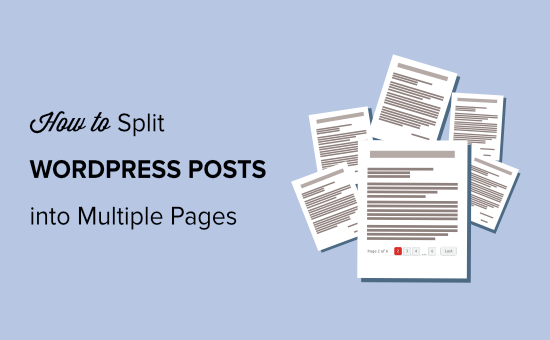
Dlaczego warto dzielić wpisy WordPress na wiele stron?
Jeśli twoje wpisy na blogu WordPress lub przewodniki są długie, to ustawienie paginacji WordPress może poprawić czytelność treści.
Pomaga to podzielić długi wpis na różne sekcje i podzielić je na wiele stron. W ten sposób odwiedzający mogą łatwo przetrawić twoją treść i przeczytać dowolną sekcję, którą są zainteresowani.
Kolejną zaletą dzielenia wpisów WordPress jest to, że może to zwiększyć zaangażowanie twoich użytkowników. Gdy użytkownicy przechodzą przez treści podzielone na strony, każda strona, którą zobaczą, przyczynia się do zwiększenia liczby odsłon, co może pozytywnie wpłynąć na ogólne wskaźniki twojej witryny internetowej.
W związku z tym przyjrzyjmy się, jak podzielić wpisy WordPress na wiele stron. Omówimy, jak podzielić twoje wpisy WordPress na wiele stron bez wtyczki i przy użyciu wtyczki WordPress:
- Metoda 1. Podział wpisu WordPress na wiele stron bez wtyczki
- Metoda 2. Podziel wiele wpisów WordPress na kilka stron za pomocą wtyczki
Metoda 1: Podziel pojedynczy wpis na wiele stron bez wtyczki
Najłatwiejszym sposobem ustawienia paginacji wpisów jest użycie bloku “Podział na strony” w twoim edytorze bloków WordPress. Nie potrzebujesz wtyczki WordPress, aby podzielić twoje artykuły na wiele stron.
Po pierwsze, musisz edytować lub utworzyć nowy wpis na swojej witrynie internetowej WordPress za pomocą edytora bloków Gutenberg.
Następnie kliknij przycisk “+” w miejscu, w którym chcesz podzielić twoją treść i dodaj blok podziału strony.
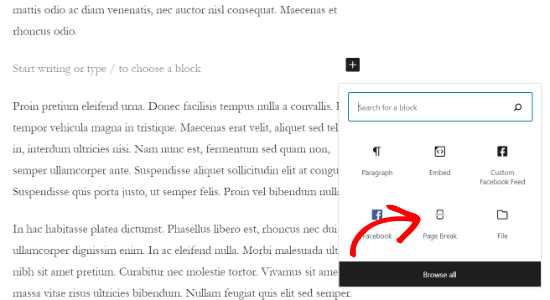
Powinieneś teraz zobaczyć linię podziału strony w twojej treści, aby wskazać, gdzie pojawi się paginacja.
Będzie to wyglądać mniej więcej tak.
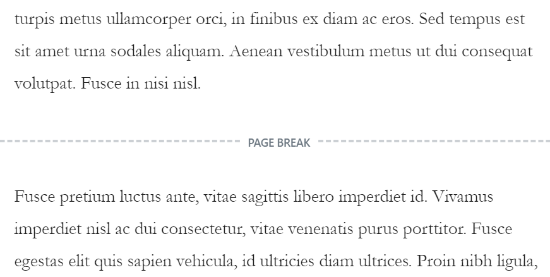
Jeśli korzystasz ze starego klasycznego edytora, możesz użyć tagu <!--nextpage-->, aby podzielić twoją treść.
Podczas pisania wpisu na blogu wystarczy przejść do widoku edytora “Tekst”, aby wpisz tagi, na które chcesz podzielić długi artykuł.
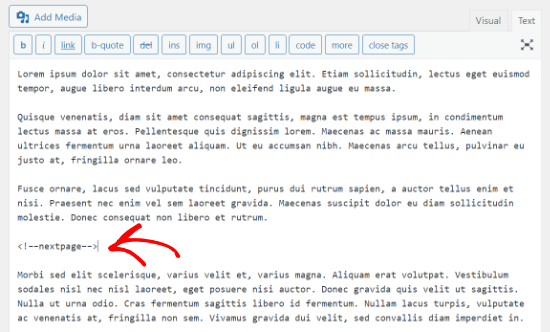
Możesz także użyć klawiszy Alt + Shift + P na twojej klawiaturze, aby wstawić podział strony. Aby to zrobić, przejdź do widoku wizualnego i naciśnij klawisze skrótu klawiat urowego w miejscu, w którym chcesz dodać podział strony.
Następnie można wyświetlić podgląd i opublikować wpis na blogu. Na dole treści wpisu pojawi się teraz paginacja wpisów.
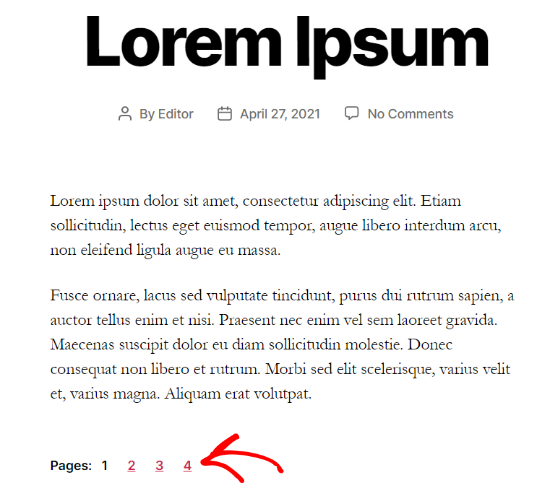
Metoda 2: Podziel wiele wpisów WordPress na kilka stron za pomocą wtyczki
Innym sposobem na podzielenie długich treści na różne strony jest użycie wtyczki do paginacji. Zaletą tej metody jest automatyczne paginowanie wpisów, gdy spełniają one określone kryteria.
W przypadku tej metody użyjemy darmowej wtyczki Automatically Paginate Posts, ponieważ jest ona łatwa w użyciu i działa z każdym motywem WordPress.
Powiadomienie: Możesz zauważyć, że ta wtyczka nie została przetestowana z najnowszymi wersjami WordPressa. Jednak sami ją wypróbowaliśmy i działa najlepiej ze wszystkich sprawdzonych przez nas wtyczek.
Dowiedz się więcej o tym, czy powinieneś używać niesprawdzonych wtyczek WordPress w naszym artykule. Jeśli znajdziesz wtyczkę, która działa lepiej niż ta, którą zaproponowaliśmy, daj nam znać w komentarzach poniżej!
Po pierwsze, musisz zainstalować i włączyć wtyczkę Automatically Paginate Posts na twojej witrynie internetowej WordPress. Więcej szczegółów można znaleźć w naszym poradniku na temat instalacji wtyczki WordPress.
Po włączeniu wtyczki na twojej witrynie, przejdź do Ustawienia ” Czytanie i przewiń w dół do sekcji “Automatycznie paginuj wpisy”.
Możesz wybrać typy treści wpisów do podzielenia na różne strony. Następnie wybierz, czy wpisy mają być dzielone według całkowitej liczby stron, czy przybliżonej liczby słów na stronę.
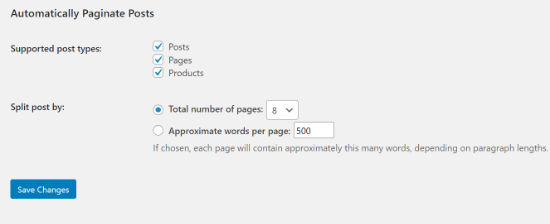
Następnie kliknij przycisk “Zapisz zmiany”, aby zapisać twoje ustawienia.
Wtyczka automatycznie podzieli twoją treść na podstawie twoich ustawień. Możesz jednak również ręcznie dodać podziały stron do twojej treści podczas korzystania z wtyczki.
Dodatkowa wskazówka: Użyj AIOSEO, aby zoptymalizować paginację twoich wpisów
Paginowanie twojego długiego wpisu może zdecydowanie poprawić wrażenia użytkownika. To powiedziawszy, ważne jest, aby odpowiednio skonfigurować wpis, aby nie miał on negatywnego wpływu na SEO (optymalizację pod kątem wyszukiwarek) twojej witryny.
Jeśli wpis na blogu jest rozproszony na wielu stronach z powodu paginacji, Googlebot może indeksować wiele kopii tej samej treści. Może to prowadzić do problemów z powielaniem treści.
Na szczęście można tego uniknąć, korzystając z wtyczki All in One SEO (AIOSEO). Ta wtyczka WordPress SEO ułatwia uczynienie twojej witryny przyjazną dla SEO, nawet jeśli nie masz specjalistycznej wiedzy technicznej.
AIOSEO automatycznie wstawi numer strony do tytułu SEO treści podzielonych na strony. W ten sposób wyszukiwarki mogą zrozumieć, że wpis został rozłożony na kilka stron i nie jest duplikatem innego wpisu.
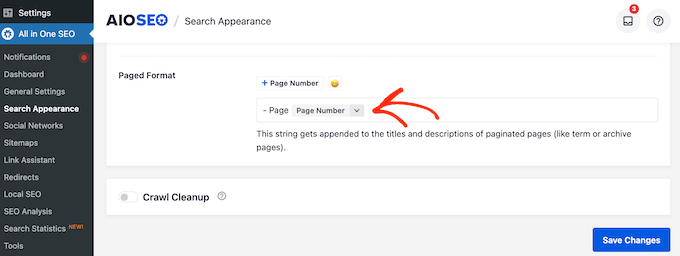
Co więcej, AIOSEO będzie usuwać te numery stron z adresów URL twoich wpisów. Pozwoli to wyszukiwarkom poznać główną stronę wpisu na blogu, którą powinny pozycjonować dla odpowiednich słów kluczowych, a użytkownicy powinni zobaczyć jako pierwszą.
Odbywa się to poprzez automatyczne włączenie ustawienia “No Pagination for Canonical URLs”.
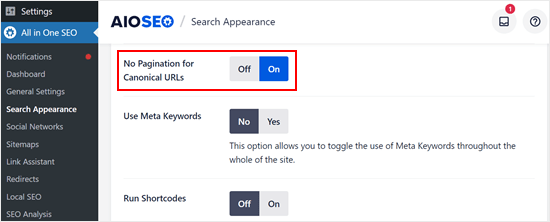
Więcej informacji na temat AIOSEO można znaleźć w naszym artykule na temat konfiguracji AIOSEO dla WordPress.
Więcej wskazówek dotyczących zarządzania długimi treściami w WordPress
Dzielenie wpisów na strony to tylko jeden ze sposobów radzenia sobie z długimi treściami. Oto kilka innych przydatnych technik, które uznaliśmy za pomocne:
- Etykietki świetnie nadają się do dodawania dodatkowych szczegółów bez zaśmiecania twojej głównej treści. Pojawiają się one po najechaniu kursorem na określone słowa.
- Zadbaj o zaangażowanie czytelników, wyświetlając im powiązane treści w samym środku twoich wpisów.
- Jeśli masz obszerny temat do omówienia, rozważ utworzenie serii wpisów zamiast pisania długiego wpisu na blogu na ten temat. Ułatwi to czytelnikom śledzenie tematu.
- Tytuł twojego wpisu jest zazwyczaj pojedynczym nagłówkiem, ale możesz podzielić go na nową linię, jeśli jest zbyt długi, aby był bardziej czytelny.
Mamy nadzieję, że ten artykuł pomógł ci dowiedzieć się, jak podzielić wpisy WordPress na wiele stron. Możesz również zapoznać się z naszym przewodnikiem na temat dodawania przycisku wczytywania większej ilości wpisów w WordPressie oraz z naszą ekspercką listą najlepszych wtyczek do powiązanych wpisów w WordPressie.
If you liked this article, then please subscribe to our YouTube Channel for WordPress video tutorials. You can also find us on Twitter and Facebook.





Jiří Vaněk
From the point of view of seo, is it better to write one long article or divide it like this and more pages? It seems to me that a long one is better from a point of view, but maybe you have other experiences?
WPBeginner Support
It heavily depends on the content and how the pagination is used but pagination should be used more for readability than SEO.
Admin
Jiří Vaněk
Thank you for answer. I know that in the past it was done very often. The user may not be afraid of a large amount of text. Personally, I’m afraid that the robot will leave the site without visiting the others, and I prefer not to do this technique and try to break up the text with graphics. Anyway, thanks for the response
Dapo
Thank you for this post. Unfortunately, this does not show anything on the frontend.
WPBeginner Support
If pagination is not working for your site, there is a chance that your theme does not allow pagination. In these cases we recommend checking with the support for your specific theme and they can normally help
Admin
Wahyu
I follow this tutorial and working fine. But i have some issue, when i click pagination on page 1 or 2 everything is going fine, but when i’m going to the last page in this case is page 3, my layout structure under pagination like a related post, comments and right sidebar are broken so my website looks ugly on thoose parts. Any suggestion related this issue?.
WPBeginner Support
You would want to reach out to the support for your specific theme and let them know about that formatting error and they should be able to assist
Admin
pankaj
can i change nextpage name
example:
name. com/love/1/
to
name . com/love/hello
WPBeginner Support
For what it seems like you’re wanting, you would want to look at changing your permalinks: https://www.wpbeginner.com/wp-tutorials/how-to-create-custom-permalinks-in-wordpress/
Admin
Al Hasan
Thanks for the tutorial, I want ask, Can I make infinite scroll on this multiple pages ?
thanks
WPBeginner Support
You would want to reach out to what you are using to set up the infinite scroll for how it handles post pagination.
Admin
Hosam
Thanks for This tut but we want to know how to make pagination for posts as we can see on your blog category not for the articles itself only
Chris
Hi guys,
may it be that this doesn’t work when using the Divi theme?
I tried, but nothing happens…
Thanks!
Dave
Your link for “two pages” goes to http://list25.com/25-hilarious-siri-responses/ and your link for “five pages” goes to http://list25.com/25-epic-fail-gifs/ … did your site get hacked or are these misleading ad links that you’re getting paid for?
WPBeginner Support
Hi Dave,
These are not misleading links. We own list25 website and they are linked in reference to show users example of how Post Pagination is used. List25 uses it to display a post on two pages and fives pages.
Admin
Lauro Carvalho
Very simple and useful! I was really looking for this. Much appreciated!
suzanne ball
That part works fine but I can’t get my title for the 2nd page to take the “/2/” so the wonderful pagination you just showed takes you TO the 2nd page
Ankit
Hello,
Thank you for this tutorial, it is helpful!
Though I want to know what to do if I want a button directing to next page of the same post, instead of 1,2,3… page number below?
How can I do that?
Rhonda
My theme is DIVI and I tried the alt, shift and p option and instead it displayed the following symbol inside worpdress editor:
∏
Its for a post and I do not use the DIVI BUILDER for posts.
Why did it not work?
Nrusingh
Sir/Madam,
Thanks for helping me many times, and I am stuck once again.
I want pagination on a page not posts. I have a page with 30 thumbnails with different page links. So, I want to paginate them into 3 pages with 12 (4 rows x 3 columns) thumbnails each. Is there a way?
Thanks In Advance
Have a nice day ahead
Shiraz
It works for me, but with some layout issue. The pagination buttons are not in same row.
Darius Spearman
Awesome…except no pagination is showing at the bottom and I don’t know what a “single.php loop” is. Can someone explain what that is and to add something to it?
Jos Mwangi
Thank you guys for this guide, I have been trying to do this the whole day! But I have a quick question though, is it possible to make the introduction appear on every page of the blog post? Like making it “sticky” at the top of every sub-page.
Jordan Ring
Thank you for the help! Spent over an hour trying to figure this out with the Divi theme. The Alt Shift P did the trick! Finally!
waqastaqee
thanks alot. thus was vary helpful. i was trying for hours but don’t get it.
“alt+ shift+ p” done
Joseph Chotard
Thank you,
This is helped me a lot as I had no idea how to create multiple pages.
Wenda
Thank you. I can’t tell you how much I appreciate this instruction. PERFECT! Thank you thank you thank you! I was thinking I’d need a plugin or theme change and well… you just solved in under 3 minutes something that I’ve already spent like 30 minutes trying to figure out! THANK YOU!
WPBeginner Support
Hi Wenda,
We are glad you found this article helpful. You may also want to subscribe to our YouTube Channel for WordPress video tutorials.
Admin
Regel Javines
I have a Twenty Ten theme of my blog
Now, ALT+SHIFT+P works for my well. However, it appears super below the post that it takes the reader to scroll down to see the 2nd page.
How can I let it appear right after the end page of the post to avoid scrolling down. And, is there any code for a button NEXT, PREVIOUS page instead of Page 1, 2? Please help…
Aizal
Thanks for this. Although need to ask, is there any plugin or code to make the pagination to appear as buttons?
Dankasaurus
Not sure if there’s a plugin but normally you would have to modify that with CSS.
Enrique
Sorry if this is stupid, but if you copy and paste the from this article, it won’t work. The dashes are different from what they should be. You have to type it directly in your editor. I copied this and it didn’t work until I typed it with the correct dashes.
Enrique
The comments system removed a word. What I meant is
“…If you copy and paste the “nextpage” from this article…”
André Quintão
Thanks, you saved me a lot of trouble. Cheers!
Cheers!
Kareem
Thank you!!!
Simo
Hello, I had to modify the single.php but rarely it worked on the last post where I did the modification and wrote sorry i don’t remember now exactly the shortcode, but when I introduced the short code in other posts it didn’t work and it appear on the post he shortode..
So, firsly it didn’t work so I tryed it on a post, then I modified the single.php and then it worked , probably later i did some modification on the single.php, and i tryed the shortcode on other post without outcome, but still working on the frst post i modified… it’ very strange why it work on a post and not on others?
May cache doing some “joke”
Thank You.
Kuen
I was going through this article how you customized the theme for list25 ( https://www.wpbeginner.com/wp-tutorials/case-study-behind-the-scenes-look-of-list25-plugins-and-hacks/comment-page-1/#comment-338067 )..
List 25 uses custom editor layout and first part of it is the “List Description” which is fixed throughout the post.. How can i do that?
sudhir k Gupta
Cont..
I am using Masonic theme
Vikas Kumar
I don’t like to use plugins for this.
So i am using above code to pagination wordpress post.
It looks like text link (Page: 1 2 3 4 5.. 10) but i want to show this in Advanced Buttons. (Advanced Post Pagination plugin provide only for Pro user.)
Please tell me how may i change Post pagination links in Advance Buttons using CSS or JS.
Bidyot
Dear Sir,
Thanks a lot. We have successfully add single post pagination as per your suggestion.
But we are facing another problem.
Pagination is displaying after our related posts display.
How can we display pagination above the related posts column.
Any help highly appreciated.
WPBeginner Support
For that you may need to edit your WordPress theme or settings of your related posts plugin. If your related posts plugin automatically adds related posts, then you need to contact plugin support to learn how you can delay it so that post pagination is shown first. If your related posts plugin provides a template tag, then you need to add that tag into your theme’s single.php or content-single or content.php template after the the_content() tag in the code.
Admin
Robert Dany
Why do I get duplicate content in google webmaster tools after splitting a blog post to 3 pages? And how to prevent this?
Bora Kurekci
The recommended solution of “Alt+Shift+p” gorgeously worked for the theme SemPress on my blog.
Thank you so much
Anthony Franck
This is really cool and it worked, kind of. The page numbers are super ugly and there is a “glaring inconsistency”.
I did see that your demo site list25 has beautiful red squares, I was wondering how you went ahead and created the nice squares?
Would it be possible to make a demo for that and send us the link?
Also About halfway through my setting this up on my website it struggles to handle the page breaks. They are all there but putting 12 jpegs between 12 page breaks freezes up my website and it won’t allow me to load anymore images on the post. Has anyone had any issues with this crashing the database? Thanks in advance for any help
WPBeginner Support
You can see the List25 CSS by right clicking on the page navigation and select Inspect from browser menu.
Admin
Dave
I’d just like to say, before anyone clicks the link in this comment, it is NSFW.
Now, on to my question.
Here is the page I want to split into multiple:
My problem is, there are around 80+ posts on that page already. How can I manually add a next page/next post/more to the page so that it can be split into multiple pages, instead of showing every single post and every single image on 1 page?
It makes it awful inconvenient. It also forces the page to take forever to load. Try it out yourself. See how long it takes to load.
Can anyone assist? What WP code can I use to break the page up? Everything I see mentions “posts” and not “pages”, unfortunately.
WPBeginner Support
Your WordPress theme should automatically handle this. It seems like either your plugin or a plugin you are using is lazy loading or pre-loading all the posts. Visit Settings » Reading page. There you can select how many posts you want to show on your blog pages. If it is already set at 10 or less, then this means you should check your plugin and themes. If it is set to a much higher number then you can change that here and save your settings.
Admin
apachx
Whenever, I insert the nextpage tag in the HTML of the post I get the page number at the bottom of the post area. But, the problem is that some other plugins like author box and wordpress related posts are being shown before the page numbering which makes it invisible to readers.
Is there any way to put the page numbering just below the post area e.g. below adsense link unit in the post area?
me
Very Bad idea
user really hate to click 1 – 9 and 9- 1 just to read it
u maybe think about How to Increase Pageviews and Reduce Bounce Rate
but user will just close the tab
Dyc3r
You can use “Next/Previous” instead of page numbers with the following:
`wp_paginate_links( array( “next_or_number” => “next” ) );`
Incidentally, this is my biggest issue with the core function. There’s a glaring inconsistency between `paginate_links()` and `wp_link_pages()` in that the latter forces you to choose between numbers and next/previous.
Granted, since this is designed to flip between pages of a single post versus pages of an “archive”, the number of available pages will (or should) be relatively low, but it would be nice to have a little more flexibility similar to what we get with archive pagination
besty
Nice post, it worked for me but how do i make the Next Page appear immediately after the post instead of after the related post? what i mean is that my site related Posts showing before the Next Page Link.
How can you help?
thanks
Mantas
Same problem here. Does anyone knows solutions to this problem?
Stephen Pate
That appears on my site and looks like Jetpack features get ahead of the pagination.
Val Archer
Hi – I’m using index.php for my posts which are all one-per-page. doesn’t work for me, so I added just below the loop in index.php but it still doesn’t work. So I saved index.php as single.php because you mention “you would need to add the following code in your single.php loop.” So I figured maybe it works only in single.php but not in index.php?
But now I can’t find where to tell wordpress to use single.php as the template for blog posts! I have a static front page. The page “Posts — Posts Page” does not give the option of choosing a template. Somehow once upon a time I told it to use the “Template Name: IndexMine” for posts. But I don’t know how or where!
Please can you tell me how I can tell wordpress to use single.php for blog posts? Then hopefully will work? Thank you!
Dyc3r
If I understand your issue correctly, you’re actually using this function in the wrong place. Think of your site like a library/bookstore where each post is a book.
— `posts_per_page` determines how many books you put on a shelf.
— `wp_link_pages()` will turn the page in the book you are currently reading
— `paginate_links()` will move to a new shelf
It sounds like you want to move to a new shelf, in which case, `paginate_links()` is the function you need
Maran
I was thinking if there a way to do it. You guys rock. I am glad that I am following on twitter.
Ali
My website contains long post and used to split them into multiple pages using ALT+SHIFT+P and this works well on my desktop theme, but when I installed WPtouch plugin I see 1 2 3 pages and when I click on any of them it reloads page no 1 .
How can i fix this problem ?
WPBeginner Support
Please contact WPTouch support.
Admin
James
But I also dont want to index 2nd and 3rd page and how to solve pagination in wordpress.
Brent
What if you have a featured image and only want it to show on the first page but not on pages 2, 3, 4, etc.?
Brent
Anyone have an answer?
Shubham Mundra
I am using MH Magzine Pro theme. When I put the nextpage tag between the article it only shows 123…. number. I want to do it like this Pre 1 2 3 Next. Is this possible?
John
“If for some reason, pagination is not showing up after you have pasted the next page tags, then you would need to add the following code in your single.php loop.”
What code?
WPBeginner Support
Thanks for notifying us. We have updated the article.
Admin
Aaron
nope not working at all for me… ugghhhhhh whyyyyyyy
Agung
Maybe not supported on your theme
maik
How to invert the pagination, I want create a page and spliting in multiples pages to show the recent posts? : This mode: 3, 2, 1. and no Pages 1, 2, 3.
semmy
Hi thank you very much for your tutorial. It’s work, oh ya I want to ask something about adsense, how we can add adsense below multiple pages, can you create a tutorial for that one? many thanks
Edwin
Thanks for the tip, I’ve recently tried this, and the pagination shows up correctly, but when clicking the links (2,3,4,etc.), i get a page not found error. Do you have any idea what would cause that?
Ricardo Cury
You might want to check you Permanent Links Structure.
Edmond
Hi,
Can you please do a tutorial on how to create the “view all” function too, as it’s really very useful. I’ve seen a similar thing here: http://list25.com/25-most-expensive-private-jets-ever-made/ (http://list25.com/25-most-expensive-private-jets-ever-made/?view=all)
Thanks!
Edmond
Hi,
Really love the feature of splitting pages. I also see that you have the “View All” option on list25.com. How can I add that same feature to my website? I’d really love to see a tutorial for this too.
João Paulo Porto
i have the same question
João Paulo Porto
If for some reason, pagination is not showing up after you have pasted the next page tags, then you would need to add the following code in your single.php loop.
Which code are you talking about? I really need this code.
Lester
Olá João Paulo,
Have you noticed how to manage pagination on wordpress long posts? This thread is not really helpful. I´m using wp 2.2.2 and I´m looking for splitting long posts in 1,2,3,4…view all pages too !
WPBeginner Staff
See how to add numeric pagination to WordPress themes.